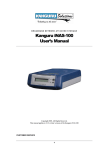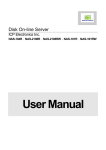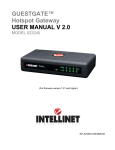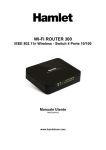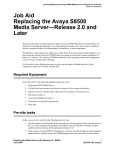Download Lenovo 8994 Personal Computer User Manual
Transcript
LevelOne FNS-5000 FNS-7000 GNS-8000 Network Attached Storage User’s Manual Version: 1.0 CUSTOMER SERVICE To obtain service or technical support for your system, please refer to the registration card for detailed contacts. TRADEMARKS LevelOne NAS TM is the trademark of Digital Data Communications. Microsoft®, Windows® and Internet Explorer® are registered trademarks of Microsoft Inc. Novell® and NetWare® are registered trademarks of Novell Inc. Apple® and Macintosh® are registered trademarks of Apple Computer Inc. All other brand or product names are trademarks of their respective companies or organizations. LIMITED WARRANTY In no event shall LevelOne’s liability exceed the price paid for the product from direct, indirect, special, incidental, or consequential software, or its documentation. LevelOne offers no refunds for its products. LevelOne makes no warranty or representation, expressed, implied, or statutory, with respect to its products or the contents or use of this documentation and all accompanying software, and specifically disclaims its quality, performance, merchantability, or fitness for any particular purpose. LevelOne reserves the right to revise or update its products, software, or documentation without obligation to notify any individual or entity. FCC STATEMENT LevelOne NAS has been tested and found to comply with the limits for a Class B digital device, pursuant to Part 15 of the FCC Rules. These limits are designed to provide reasonable protection against harmful interference in a residential installation. This equipment generates, uses, and can radiate radio frequency energy and, if not installed and used according to the instructions, may cause harmful interference to radio communications. However, there is no guarantee that interference will not occur in a particular installation. If this equipment does cause harmful interference to radio or television reception, which is found by turning the equipment off and on, the user is encouraged to try to correct the interference by one or more of the following measures: z Reorient or relocate the receiving antenna z Increase the separation between the equipment or device z Connect the equipment to an outlet other than the receiver’s z Consult a dealer or an experienced radio/TV technician for assistance CAUTION Danger of explosion if battery is incorrectly replaced. Replace only with the same or equivalent type recommended by the manufacturer. Dispose of used batteries according to the manufacture's instruction. 1 Contents Overview...................................................................................................................................................... 3 Package Contents ...................................................................................................................................... 3 System Overview ...................................................................................................................................... 3 Installation and Set-up of LevelOne NAS............................................................................................... 6 Installing the Hardware ............................................................................................................................. 6 Set-up before First Operation .................................................................................................................... 9 Administration of the LevelOne NAS ..................................................................................................... 10 Accessing the Administration Page ......................................................................................................... 10 Administration ......................................................................................................................................... 12 Quick Configuration ................................................................................................................................ 13 System Settings ....................................................................................................................................... 13 Network Settings ..................................................................................................................................... 14 Disk Configuration .................................................................................................................................. 16 User Management.................................................................................................................................... 17 Network Share Management ................................................................................................................... 20 System Tools ........................................................................................................................................... 21 Statistics & Logs ..................................................................................................................................... 23 Accessing the LevelOne NAS ................................................................................................................... 24 Using Microsoft Windows ...................................................................................................................... 24 Using the Apple Mac Operating System ................................................................................................. 25 Using the Unix/Linux Operating System ................................................................................................ 31 Using Novell NetWare ............................................................................................................................ 31 Using a Web Browser.............................................................................................................................. 31 Using File Transfer Protocol (FTP) ......................................................................................................... 31 LevelOne NAS - Maintenance ................................................................................................................. 32 Shutdown/Restart the Server ................................................................................................................... 32 Reset the Administrator Password & Network Settings .......................................................................... 32 Disk Failure or Malfunction .................................................................................................................... 32 Power Outage or Abnormal Shutdown .................................................................................................... 33 Appendix A LCD Panel .......................................................................................................................... 34 Displayed Information ............................................................................................................................. 34 Checking IP address, system and disk information ................................................................................. 34 System Setting Function .......................................................................................................................... 35 Appendix B Web File Manager ............................................................................................................. 36 Using Web File Manager......................................................................................................................... 36 Web File Manager Icon ........................................................................................................................... 38 Appendix C Quick Install Wizard ......................................................................................................... 39 Introduction ............................................................................................................................................. 39 Screenshot ............................................................................................................................................... 39 Operation Help ........................................................................................................................................ 40 2 Chapter 1 Overview Package Contents • • • • • Network Attached Storage Appliance User’s Manual Power Cord One CAT-5 Ethernet Cable Quick Install Wizard CD-ROM System Overview FNS-5000 z Front View LCD Panel Setting Switch A 4 LED indicators: Power, Error, Network, and Disk Access Setting Switch B z Rear View Configuration Reset Switch Power Switch RJ-45 Network 3 FNS-7000 LCD Panel z Front View Setting Switch A 4 LED indicators: Power, Error, Network, and Disk Access 4 IDE Hard Disk Drives Setting Switch B z Rear View Configuration Reset Switch Power Switch RJ-45 Network ATX Redundant Power Supply GNS-8000 z Front View Setting Switch A LCD Panel 4 LED indicators: Power, Error, Network, and Disk Access Setting Switch B z Rear View ATX Redundant Power Supply RS232 Connector ( for UPS ) SCSI Connector ( for Tape Drive ) 4 Configuration Reset Switch RJ-45 Network Power Switch Indicator light at the left of the LCD panel Shines when power is on Indicates a system error which needs to be corrected This light flashes when data is being transmitted through the network This light flashes when data is being stored or retrieved from the disks 5 Chapter 2 Installation and Set-up of LevelOne NAS Installing the Hardware Install Hard Drive into FNS-7000 Once you start installing a hard drive into the FNS-7000, you have to obey following steps: Power off the FNS-7000. Release the screws(right & left sides) of drive bay in which the new hard drive will install. Make sure the hard driver’s jumpers ”Master/Slave” setting are set to “Cable select” when you put the new hard drive into the drive tray. Instructions of new hard drive settings, please refer to the user guide along with the new hard drive. Attach the power cable from drive tray to your new hard drive. Attach the IDE connector to the new hard drive. ( please keep around 15~20˚ between hard drive and drive tray) Put the screws into the drive tray’s down side to tighten new hard drive. 6 Slide the drive tray with new hard drive into the drive and tighten the screws (right & left sides). Install Hard Drive into GNS-8000 Once you start installing a hard drive into the GNS-8000, you have to obey following steps: Power off the GNS-8000. Push the front panel ears and pull out the panel. Unlock the drive bay in which the new hard drive will install. Make sure the hard driver’s jumpers ”Master/Slave” setting are set to “Cable select” when you put the new hard drive into the drive tray. Instructions of new hard drive settings, please refer to the user guide along with the new hard drive. Attach the power cable from drive tray to your new hard drive. Attach the IDE connector to the new hard drive. ( please keep around 15~20˚ between hard drive and drive tray) 7 Put the screws into the drive tray’s down side to tighten new hard drive. Slide the drive tray with new hard drive into the drive and push forward the panel. The following steps will guide you through the LevelOne NAS hardware installation: 1. Connect the LevelOne NAS to your Network.. 2. For GNS-8000 only: If you want to back up your files to the tape, please connect the tape drive to the SCSI port on the back of your LevelOne NAS. Then turn on the tape drive 3. For GNS-8000 only: To use a UPS with your unit, please connect the UPS to the RS232 port on the back of your LevelOne NAS via a serial cable. And connect the power plug of the LevelOne NAS to the output power inlet of the UPS 4. Power on the LevelOne NAS. Note: The power switch uses toggle switch design (after pushing the button it will return to the original position). All you need to do is to flip the switch once to turn-on or turn-off. When all power cables have been properly connected, push the Power Switch on the back of the LevelOne NAS. The LCD Panel will light up and the system is ready for set-up: Server Name Date NAS001122 192.168.0.1 05/22 02:48 IP Address Time 8 At this time the hardware installation of your LevelOne NAS is complete. Please proceed to “Set-up before First Operation”. Set-up before First Operation The factory default settings of your LevelOne NAS will search the network via DHCP (Dynamic Host Configuration Protocol) to automatically detect IP address settings. If your network does not support the DHCP protocol, the LevelOne NAS will use the default settings listed below: IP Address 192.168.0.1 Subnet Mask 255.255.255.0 Once the LevelOne NAS completes its boot-up process, the LCD panel displays the current IP address settings. If your network does not support the DHCP protocol, you must configure your LevelOne NAS to the proper LAN settings before using it for the first time. (If you do not know your LAN settings, please contact your network administrator). 1. Use the LCD panel to change the network settings. Appendix A. For more information, see 2. Use the Quick Install Wizard on the disk or the CD-ROM to change the network settings. For more information, see Appendix C. Once you complete the LevelOne NAS settings, you can use your web browser to perform further administrative settings. 9 Chapter 3 Administration of the LevelOne NAS Once you have installed the LevelOne NAS and other hardware and connected it to the networks, you can use your browser (supports Microsoft Internet Explorer 5.0 or later and Netscape Navigator 4.5 or later; Microsoft Internet Explorer 5.5 is recommended) to complete administrative tasks for the LevelOne NAS. Accessing the Administration Page The following methods allows administrator to access the Administration page: 1. Launch your web browser (Microsoft Internet Explorer version 5.5 is recommended). If you know the IP address of the LevelOne NAS, type the IP address in the address bar of the browser and press “Enter”. The IP address can also be obtained on the LCD display of the LevelOne NAS (see Appendix A). 2. Use the Quick Installation Wizard (see Appendix C) and double-click on LevelOne NAS in the list which appears. When the browser displays the home page of your LevelOne NAS, click on the Administration link. Enter the user name and password to continue the administration setup. 10 The factory default login name and password are as follows: Login: Password: Administrator admin If this is the first time you enter the Administration page, the Quick Configuration page appears automatically. Please refer to the Quick Configuration section for more details. 11 Administration The Administration comprises the following eight sections: Administration D Quick Configuration D System Settings D Server Name D Date & Time D Language Setting D View System Settings D Network Settings DTCP/IP Configuration DMicrosoft Networking DApple Networking DNFS Service DNetWare Service DWeb Service DFTP Service DView Network Settings DDisk Configuration DCreate Disk Volume DSingle Disk Volume DRAID 5 Disk Volume DRAID 1 Mirroring Disk Volume DRAID 0 Striping Disk Volume DLinear Disk Volume DDelete Disk Volume DExamine Disk Volume DFormat Disk Volume DView Disk & Volume Status DUser Management DUsers DCreate DChange Password DCreate Private Network Share DAssign User Groups DNFS Settings DQuota Settings DDelete DUser Groups DCreate DCreate Private Network Share DAssign Users DDelete DPDC Authentication Settings DQuota DBackup / Restore User Settings DNetwork Share Management DCreate DProperty DAccess Control DDelete DSystem Tools DSNMP Settings DAlert Notification DRestart / Shutdown DHardware Settings DUPS (GNS-8000 only) DSystem Update DChange Logo DTape Backup (GNS-8000 only) DStatistics & Logs DActive Users DEvent Logs DDHCP Logs 12 Quick Configuration The Quick Configuration will guide you through the configuration process step-by-step, as follows: 1. Enter the name, workgroup and description for this server. 2. Change the administrator's password. 3. Enter the date, time and time zone for this server. 4. Select the language that this server will use for file names. 5. Enter the IP address, subnet mask and default gateway for this server 6. Select the network file services that you want to provide on this server. 7. Configure disk volume on this server. 8. Configure the method of user authentication. 9. Manage users and user groups for this server. 10. Manage network shares on this server. Due to different configurations, it might takes from 3 to 10 minutes to complete the Quick Configuration. System Settings Basic system settings include the server name, date, time, and language settings. • Server Name You must assign a unique name for your LevelOne NAS for ease of identification within the local network. The server name can accommodate as much as 14 characters, which 13 can be a combination of letters (A-Z or a-z), numbers (0-9) and hyphens (-). The server will not accept name containing blank spaces, period (.), or names with only numbers. The LCD display will show the current server name. Next, you must configure your LevelOne NAS to the workgroup. The workgroup represents a basic computer group within the Microsoft Network. Files are normally shared within the group. Workgroups can accommodate as much as 15 characters but must exclude the following characters: ;:"<>*+=\|?,[]/ The first character cannot be a period (.). For ease of management and usage, please set your LevelOne NAS and attached computer(s) in the same workgroup. Moreover, the LevelOne NAS allows you to specify comments (such as administrator name, department, or location) that describe the LevelOne NAS for ease of identification to an on-line user. • Date & Time Set the date, time, and time zone according to your current location. If the settings are incorrectly entered, the following problems may occur: 1. When using a web browser to access or save a file, the time of the file accessed or saved may be out of sync. 2. The system event log time will be incorrect compared to the actual time an action occurred. • Language Setting The server is based on the language settings and uses it accordingly while creating or displaying files and directories. Select the correct language settings to avoid the following problems: 1. Inability to create files or directories with special wording. 2. Inability to display files or directories name with special wording. Network Settings The network settings include TCP/IP configuration and network service settings. • TCP/IP Configuration According to your local network, you can choose the following two methods to configure the TCP/IP settings: 1. Obtain IP address settings automatically via DHCP If your network supports DHCP, the LevelOne NAS will automatically use the DHCP protocol to retrieve the IP (Internet Protocol) address and related information. 14 2. Use static IP address Use the user defined IP address settings. • Fixed IP Address The IP address is a 32-bit digit code used to differentiate each single entity on a network. The IP address is separated into 4 groups of eight bits separated by dots: 192.168.0.1 • Subnet Mask The subnet mask is used to define computer within the same local network. It is a 32-bits digit code: 255.xxx.xxx.xxx. • Default Gateway The gateway is generally referred as an interchange point that connects two networks, such as LAN and WAN. If you don’t need to configure gateway address, just set it as 0.0.0.0. • Enable DHCP Server Once the DHCP server’s dynamic address allocation function is activated it will automatically assign dynamic addresses to any computer in the network that is configured to automatically obtain IP addresses. Note: Only one DHCP server may be activated at any time in a network to avoid causing conflicts in communication. • Microsoft Networking Users using the LevelOne NAS on the Microsoft Windows operating systems must start Microsoft Network Services. If the local network has a WINS server installed, please specify the IP address. The LevelOne NAS will automatically register its name and IP address with the WINS service. Or you can enable your LevelOne NAS as the WINS server for your network. • Apple Networking Users using the LevelOne NAS on Apple’s Mac operating systems must enable AppleTalk network support. If your AppleTalk network uses extended networks, and is assigned with multiple zones, please assign a zone name to the LevelOne NAS. If you do not want to assign a network zone, please enter an asterisk (*). Asterisk (*) is the default setting. • NFS Service Users using LevelOne NAS on Unix/Linux operating system computer or server must start Unix/Linux NFS service. The LevelOne NAS supports NFS version 2.0. To correctly use the NFS service, you must assign a User’s UID and IP address. Please select User Management · Users · NFS Settings to start the setup. 15 • NetWare Service If you wish to use NetWare to access the LevelOne NAS, you must activate the NetWare service. The LevelOne NAS will then operate in a manner similar to a Novell NetWare 3.12 file server. • Web Service Other than standard OS support, you have the choice to use a web browser to access your files on the LevelOne NAS. If your LevelOne NAS is connected to the Internet and uses a valid IP address, the LevelOne NAS allows you to access your files using a web browser from anywhere in the world. • FTP Service If you wish to download files from or upload files to your LevelOne NAS by using file transfer protocol (FTP), you must first activate the FTP service. Disk Configuration The LevelOne NAS can accommodate a maximum of four disks. The Disk Volume can be configured according to your needs. • Single Disk You can choose to use a stand-alone disk. However, if the disk is damaged, all data will be lost. • RAID 5 Disk Volume Three or more hard disks can be teamed up to form a large-capacity RAID 5 disk group. This system will distribute and store data among its various member disks as it is received. At the same time it uses an amount of space roughly equivalent to a whole disk to store reference numbers with the same elements. Should one of the disks in the group suffer some kind of damage, you can shut down the computer and install a new disk, and the system will restore the data on the new disk using the reference number. In addition, if you have a system with four disks but use only three in your RAID 5 group, the fourth will serve as a backup disk. If one of the three disks is damaged the system will automatically start using the spare disk without powering down and changing the affected disk. Generally speaking, the capacity of a RAID 5 disk group is one disk’s worth of space less than the total rated capacity of the group. Note. RAID 5 may be used only with equipment which has three or more disks. • RAID 1 Mirroring Disk Volume Mirroring Disk protects your data by automatically backing up the contents of one disk onto the second disk of a mirrored pair. This protects your data if one of the disks fails. Unfortunately, the storing capacity is equal to a single disk, as the second drive is used to automatically back up the first. Mirroring Disk is suitable for personal or corporate use to store important data. 16 • RAID 0 Striping Disk Volume Striping disk combines two or more disks into one larger disk. It offers the fastest disk access but it does not have any protection of your data if the striped array fails. The disk capacity equals the number of disks in the array times the size of the smallest disk. Striping disk is usually used to maximize your disk capacity or for fast disk access but not for storing important data. • Linear Disk Volume You can combine two or more disks into one larger disk. During file saving, the files are saved on physical disks sequentially but do not have a disk failure file protection function. The overall capacity of linear disks is the sum of all disks. Linear disks are generally used for storing large data and are not appropriate to use for file protection of important data. By factory default, the LevelOne NAS has been pre-set into one large disk. If you wish to use other disk configurations, the settings can be changed during the first Quick Configuration access. Furthermore, to increase the hard disk life, the hard disk will go to standby mode if there is no access within 30 minutes. If any data access happens while the hard disk is in stand-by mode, it will take 3 or 5 seconds for the hard disk to return to normal mode. You can select System Tools · Hardware Settings to change the setting. You can also perform the following disk administration: • Create Disk Volume • Delete Disk Volume • Examine Disk Volume • Format Disk Volume • View Disk & Volume Status User Management The LevelOne NAS can share its files with multiple users. It is important to plan and organize users and user groups’ accessibility to ease the administration work. • Users The factory default settings contain the following user settings: Administrator By default, the administrator is a member of the administrators group and has access to the system administration. You cannot delete the user Administrator. Guest When you use a non-registered user name to login, the server recognizes it as a Guest and will allow limited access. A guest does not belong to any user group. You cannot delete the user Guest or create a password. 17 Anonymous When you connect to the server by FTP service, you can use the name to login as a guest. You cannot delete this user or change its password. You can create a new user according to your needs. The following information is required to create a new user: • User Name The user name must not exceed 32 characters. It is case insensitive and it can contain double-byte characters. (Such as Chinese, Japanese, and Korean) But it cannot contain any of the characters below: " / \ [ ] : ; | = , + * ? < >` ' • Password The password must not exceed 16 characters. Due to security concerns, the password must be at least 6 characters. Try to avoid using codes that are easily decipherable. You can perform the following settings for users: • Create User • Change Password • Create Private Network Share • Assign User Groups • NFS Settings • Quota Settings • Delete User • User Groups To administer access rights, you can create user groups. User groups are a collection of users with the same access rights to files or folders. By factory default, the server contains the following pre-defined user groups: Administrators All members of the administrators group have the rights to perform system management. You cannot delete the administrators user groups. Everyone All registered users belongs to everyone group. You cannot delete the user groups, “Everyone” or delete any of its users. 18 You can administer user groups with the following: • Create User Groups • Create Private Network Share • Assign Users • Delete User Groups User groups name must not exceed 256 characters. It is case insensitive and it can contain double-byte characters. (Such as Chinese, Japanese, and Korean) But it cannot contain any of the characters below: " / \ [ ] : ; | = , + * ? < >` ' To properly manage security, it is very important to manage users and user groups. You may set the share access parameters of each user or user group accordingly. • PDC Authentication Settings If you have a Windows PDC (Primary Domain Controller) server to handle the domain security in your network, you don’t need to re-enter all the users and groups with the LevelOne NAS. You can simply enable the PDC authentication feature; the LevelOne NAS will connect with the NT domain and get all the information of the domain users and groups automatically. To enable PDC authentication, you must enter the domain name as well as the user name and password already established in this domain. The LevelOne NAS will use the user name and password to log in to the NT domain and retrieve user and group information. Once you have configured the LevelOne NAS to use PDC authentication, all NT domain users and groups will appear in lists of users and groups for which you can define access rights. Note: NetWare users cannot be authenticated via the PDC server. To properly authenticate NetWare users, please go to User Management · Users · Change Password page and type the password for that user manually. • Quota The amount of space given out to all users in the system can be limited in order to manage and allocate it efficiently. Once these restrictions are in place, users will be prevented from obtaining more space once they have reached their limit. This prevents monopolizing of a large amount of disk space by a small group of users. No limitations are set on the system when it leaves the factory. • Backup/Restore User Settings You may back up all user settings on to your computer as well as restore previously backed up user settings file to your LevelOne NAS. This function allows you to easily maintain the user settings. 19 Network Share Management The primary purpose of network storage is file sharing. In a standard operation environment, you can create different network share folders for various types of files, or provide different file access rights to users or user groups. By factory default, a “public” share folder is created. The share folder gives full access to all users or guests. Administer network shares with the following: • Create a Network Share • Change the name, path and comment of a network share • Set access right for a network share • Remove a network share You can create new network shares according to your needs. While creating a network share the following parameters must be set: • Network Share Name The network share name must not exceed 12 characters. It cannot contain double-byte characters (such as Chinese, Japanese, and Korean) as well as the characters listed below: ".+=/\:|*?<>;[]% • Disk Volume The network share will be created under the specified disk volume. • Path All data are stored under the assigned path onto the disk volume. You can select Specify Path Automatically to allow the server to automatically create a new path on the disk volume to store the network share files. Or you can assign a specific path for the share folder. The manually assigned path cannot exceed 256 characters and cannot contain the characters listed below: "\:|*?<>;`' • Comment The Comment field allows a brief description of the share folder to help users identify its purpose in a network neighborhood window. The comment cannot exceed 128 characters. Once the network share is created, you can start assigning access rights to users or user groups: • Full Access Full access allows the user or user group to read, write, create, or remove all files and directories in the network share. • Read Only Reads files only in the network share but denies functions to write, create or delete files or directories. 20 • Deny Access Denies all files access on the network share. System Tools The following system tools allow optimized maintenance or management of your LevelOne NAS: • SNMP Settings In order to use Simple Network Management Protocol (SNMP) to manage the LevelOne NAS's network components, the SNMP service must be started. • Alert Notification Configures administrator’s e-mail address and SMTP server IP address. In case of warning or malfunction, an email is automatically sent to the administrator. • Restart / Shutdown Powers off or restarts the LevelOne NAS. • Hardware Settings You can enable or disable the following hardware functions of your LevelOne NAS: 1. Enable LCD panel setting function The default is enabled. Allow you to change the TCP/IP configuration using the LCD panel buttons. 2. Enable configuration reset switch The default is enabled. Depress and hold on the configuration reset switch for 5 seconds to reset the administrator password and network settings to the factory default. 3. Enable hard disk standby mode The default is enabled. Hard disk will go to standby mode if there is no access within the period you specify. 4. Enable buzzer Default setting is enabled. If the buzzer is disabled, it will not sound when a system error occurs, but the warning light will still shine. • UPS (For GNS-8000 Only) The LevelOne NAS is equipped with a serial port interface to support UPS (uninterrupted power supply) connection. By connecting the UPS to the serial port and enabling the UPS support, you can protect the system from abnormal shutdown caused by power outage. In the event of utility power failure, the system will shut down automatically by probing the power status of the connected UPS unit. You can also set a shutdown timer to power off the system automatically after it detects the AC power failure. In general, the UPS can keep supplying the power for the system for about 5 to 10 minutes. But this depends on the maximum load of the UPS and the number of the loads connected to it. If the UPS you used is not supported, please contact technical support or visit our web site for updated news. • System Update Performs system software updates. Make sure that the image file that you are about to 21 update is the correct version and read through the instructions carefully. It is wise to back up all existing data on the LevelOne NAS prior to performing system software update. The current settings will remain unchanged after the system is upgraded. • Change Logo You can place a picture that you desire on the upper right corner of the home page. The size of the picture cannot exceed 20K • Tape Backup (For GNS-8000 Only) The tape backup tools allow you to perform the backup or restore jobs using a tape drive with ease. In principal, there are two different types of backups: Full Backup or Incremental Backup. Full backup will back up all the files in the backup source. However, the incremental backup will only back up any modified or new files after last backup. Backup Now To back up the files to the tape right away, you can run an immediate backup job. Restore To restore from the previously backup tape, you can perform the restore operation. Scheduled Jobs You can schedule a backup job to be executed automatically at any later time periodically. Tools There are several useful tape functions to operate on the tape drive. For example, you can rewind, eject or erase the tape here. Job Status You can review or monitor the status of the backup or restore job. Note: 1. The SCSI tape drive has to be properly connected and turned on before starting the system, or it will not be detected. 2. The HVD (High Voltage Differential) SCSI tape drive is not supported by this system. 22 Statistics & Logs You can monitor the current logon user of the LevelOne NAS and the system event logs for the purpose of user administration or system diagnostic reference. • Active Users Displays information on all online users. • Event Logs The LevelOne NAS can store thousands of recent event logs, including warning, error and information messages. In the event of a system malfunction (LCD error indicator lights up), the event logs can be retrieved to help diagnose the system problem. • DHCP Logs If the DHCP server function is activated, you can use it to monitor all of the assigned dynamic addresses, client MAC addresses and other information. 23 Chapter 4 Accessing the LevelOne NAS Using Microsoft Windows Under the Microsoft Windows operating system, you can access the LevelOne NAS using the following steps: 1. Use the following methods to locate and connect the LevelOne NAS within the local network: • Click on the Start button and select Run in the Windows menu bar. Enter the name of the LevelOne NAS, for example: \\NAS004001, and press Enter. • You may also look for the LevelOne NAS within the Network Neighborhood. Locate the workgroup and find the name of your LevelOne NAS. When the server is found, double-click on the server name to connect. • You may also use the “Search for Computers” function to look for your LevelOne NAS in Windows. Under Windows ME or Windows 2000, please follow these steps: 1. Open “My Network Places” folder. 2. Under the tools bar menu click “Search”. 3. Computer Name path key-in LevelOne NAS name. 4. Click once on Search. Once the LevelOne NAS is found, double-click your mouse button to connect. 2. Once the connection to the LevelOne NAS is successful, all listing on your available network share are displayed. Move the mouse pointer to the network share you want to access and click the right button once. A popup menu appears; select “Map Network Drive”. A popup window that allows you to assign a drive letter for the network share appears (note: do not use the drive letter used by the CD-ROM). If you wish to make the share folder available for your next start-up, check the “Reconnect at logon” box on the popup window and click on “OK” to make the network share as one disk drive in your system. 24 3. Once the network share is a part of your system disk drives, you can locate the network share in “My Computer” and access it as a regular hard disk drive. Using the Apple Mac Operating System If you are a Mac OS user, you can use the following two methods to access to your LevelOne NAS: 1. Using Network Browser a. Choose “Network Browser” in the Apple menu. 25 b. In the “Network Browser”, choose AppleTalk; a list of all computer on the AppleTalk network appears. Choose the LevelOne NAS. c. Once the LevelOne NAS is chosen, the system will request you to input the login name and password. Click then “Connect” or use “Guest” to enter. When the login name and password are confirmed, a popup window informs you that the connection is made with the LevelOne NAS. d. When the LevelOne NAS is connected, the network browser displays all the network shares. You can then access or drag & drop the share folders. 26 e. Choose either one of the network shares to start to link. The network share appears on the Mac OS desktop. 27 2. Using the Chooser a. Select Chooser in the Apple menu bar. b. Click on AppleShare. The name of the LevelOne NAS appears on the right side of the window. 28 c. Use the mouse to highlight the LevelOne NAS and then click on the “OK” button located at the bottom right-hand side of the screen. d. Enter the correct login name and password or use “Guest” to login, then click on “Connect”. 29 e. All available network shares will be listed. Use the mouse to choose a network share and click on “OK”. f. You can then close the Chooser program. Double click on the icon on the desktop to access your files. 30 Using the Unix/Linux Operating System Other than Microsoft OS and Mac OS, your LevelOne NAS supports Unix based systems (such as IBM AIX, HP-UX, Sun Solaris, Linux, Free BSD, etc) through the NFS service: 1. Under Unix, use the following commands: mount -t nfs <LevelOne NAS IP address>:/<Network Share Name> <Directory to Mount> For example, if your LevelOne NAS’s IP address is 192.168.0.1 and you want to link the network share folder “public” under the /mnt/pub directory, use the following command. mount -t nfs 192.168.0.1:/public /mnt/pub Note: You must login as “root” user to initiate the above command. 2. Logged in as the user id that you defined, you can use the mounted directory to access your network share files. For more information about NFS settings, please refer to your Unix system documentation. Using Novell NetWare If you are accessing the LevelOne NAS from the NetWare client, please refer to the NetWare user’s manual for more information. The LevelOne NAS functions as a NetWare 3.12 file server. Using a Web Browser Other than OS support, your Disk On-line Sever also provides a convenient web style file management that allows using a standard web browser to access your data. If you link the LevelOne NAS onto the Internet and use a public IP address, you can logon to access the files from anywhere in the world. For more information, please refer to Appendix B. Using File Transfer Protocol (FTP) In addition to working with multiple operating systems, the LevelOne NAS also supports FTP. You can use popular FTP software and enter the user name and password to connect to the LevelOne NAS. Or you may key in anonymous as the user name in order to access public network share folders that is open to guest users. 31 Chapter 5 LevelOne NAS - Maintenance The LevelOne NAS has been specially designed to run on 24 hours, 7 days a week and to be ready at all times. It is also robust to protect against system crashes caused by power loss. This section provides a general maintenance overview. Shutdown/Restart the Server Please use the following steps to shutdown/restart the server: 1. Ask all the connected users to save their working files and stop using the LevelOne NAS. 2. Open the administration web page and go to System Tools · Restart/Shutdown. Follow the instructions to restart or shutdown the system. Reset the Administrator Password & Network Settings If you accidentally forget the administrator password, you will not be able to perform any administration work on the LevelOne NAS. Under this condition, you can reset the administrator password and network configuration to the factory default. 1. Use the tip of a ball point pen and depress the configuration reset switch located on the back of the LevelOne NAS. Hold it for about 5 seconds until the beep. 2. The network configuration will be reset, and you may need to re-configure some or all of the network settings before you can connect to the LevelOne NAS. 3. Use a web browser to connect to the LevelOne NAS. Enter the System Administration and enter the following login name and password. Login: Password: Administrator admin You can then perform system administration. Note: If the configuration reset switch is disabled in the System Tools · Hardware Settings page, you are no longer able to use this function. Please remember your administrator password. Disk Failure or Malfunction If you are suffering from a disk failure or malfunction, please do the following: 1. Log all abnormal events or messages for technician’s reference. 2. Stop all operations of the LevelOne NAS and power it off. 3. Contact the customer service for technical support. 32 Note: Your LevelOne NAS must be repaired by a trained technician. Please do not try to repair the LevelOne NAS on your own. Power Outage or Abnormal Shutdown In the event of power outage or abnormal shutdown of the LevelOne NAS, the system should return to its original state prior to shutdown or power outage after restart. If the system is not operating within normal parameters, please proceed with the following steps: 1. In the event of system configuration setting lost during power outage or abnormal shutdown, please manually reset your desired configurations. 2. In the event of system operating abnormally or error message, please contact customer service for support. To prevent similar occurrence, please periodically backup all critical files or folders and remember the following tips: 1. Please follow Shutdown/Restart the Server steps described above for normal shutdown or restart. 2. If you are able to anticipate power outage, please backup all critical files or folders prior to power outage and shutdown your server normally. Restart your server once the power has returned to normal. To prevent major lost of data in the event of a disk failure, please back up your data periodically. 33 Appendix A LCD Panel Displayed Information After system powers on, the following information is displayed on the LCD panel: Server Name Date Power Error Network NAS4020 61.235.61.33 05/22 02:47 Hard Disk IP Address Setting Switch A (Button A in the text below) Setting Switch B (Button B in the text below) Time Checking IP address, system and disk information Click on B to show the available disk space. Please note that this is actually the entire amount of disk space, and not the amount of space that you can use. DISK NUMBER: 4 SIZE: 38361.09MB Click on B again to show current CPU temperature and fan speed. Note: NAS-2000 will not show this information. TEMP: 32o C FAN : 3590 RPM Click B again to display the model number and version information as shown below: NAS4020 2.11(0311) 34 System Setting Function z Enter System Setting 1. Press the switch A for two seconds to enter System Setting. 2. Press the switch B for selection options. 3. Press the switch A to enter the selection options. z NETWORK SETTINGS Enter the Network Setting, press the switch B to choose DHCP or Static IP. 1. Obtain IP Address Automatically (DHCP) DHCP will automatically obtain IP address settings. 2. Specify Static IP Address (STATIC IP) press the switch A to select STATIC IP and complete the following steps: • SET STATIC IP Press the switch B to set the IP address settings (press the switch B to select the number 0~25)/ Press the switch A for the next number. • SET NETMASK Follow the same procedure as above. • SET GATEWAY Follow the same procedure as above. • SELECT STATIC IP Press the switch B to select YES or NO and confirm by pressing the switch A.NO will return to the Network Settings menu. • RESTART SYSTEM You need to restart the system to make changes effective. Press the switch B to select YES or NO and press the switch A to confirm. z POWER DOWN Press the switch A to shutdown the system. z REBOOT SYSTEM Press the switch A to reboot the system. z EXIT Press the switch A to exit the settings menu. 35 Appendix B Web File Manager Using Web File Manager Start your web browser and enter your LevelOne NASs home page. Select Web File Manager and enter the correct login name and password. You may also enter “guest” in the login name field with no password to access the network shares on the LevelOne NASs as an anonymous guest. The LevelOne NASs allows you to organize your network share folders on-line. You can save these files inside folders as well as rename and remove files or folders. • How to View Files On-line Click on a file displayed on the web page. The file’s data are displayed on the browser. If your browser does not support the file format, the download window pops up automatically. Once the file is downloaded, you can open it on your computer. • How to Create Folders 1. Enter the folder that you want to create the new folder. 2. On the tool bar, click on ( Create Folder ). 3. Enter the name of the new folder and confirm. • Renaming Files or Folders 1. Select the file or folder you want to rename. ( Rename ). 2. On the tool bar, click on 3. Enter the new file or folder name and confirm. • Deleting Files or Folders 1. Check the file(s) or folder(s) you wish to delete. 2. On the tool bar, click on ( Delete ). 36 3. A window appears. Click on OK to delete the selected file or folder. ( Select All ),then click on ( Delete ). To delete all files and folders, click on • Uploading 1. Enter the folder of the file you want to upload. 2. Click on “Browse…” to select the file you want to upload. 3. Click on “Upload”. • Downloading 1. Click the right mouse button on the file which you want to download. 2. A context menu appears. Click on “Save Target As…” to download the file. • Logging out Web File Manager On the tool bar, click on ( Logout ) to leave the web file manager. 37 Web File Manager Icon Up - go back to the parent folder Refresh – reload the current page Home - go back to the network shares list home page Create Folder – create a new folder Rename – rename the selected file or folder Delete – remove the selected file(s) or folder(s) Select All – select all files and folders Select None – cancel all selection Logout – leave the web file manager Full access network share folder Read-only network share folder Malfunction network share folder 38 Appendix C Quick Install Wizard Introduction The Quick Install Wizard enables you to list the LevelOne NASs within your local network, and display basic information such as server names, workgroups and IP addresses. You may also set up the server name, date/time and basic network configuration of the LevelOne NAS via this program. Screenshot Indicates the IP address of the server. All LevelOne NASs can be identified using a unique server name. Windows workgroup joined by the LevelOne NAS. Set up Server Name, Date, Time and basic network configurations. View detailed information about the selected server. Re-search for LevelOne NASs in the network zone 39 Display operating instructions for the Installation Wizard Configuration complete; exit program Operation Help 1. Set up your LevelOne NAS: Select the LevelOne NAS that you want to configure, and then click on the Configure button. An authentication window asking you to enter the administrator’s password appears as shown below: Click on OK after entering the password.. If the name and password are correct, the configuration window is displayed on the screen: Name for this LevelOne NAS. You can input any name you want except special characters. The maximum length is 14 characters. If this option is enabled, the server obtains the IP address automatically from the DHCP server. Date Time Enter the IP address exclusively assigned to this server. The subnet mask is used to distinguish the network ID and host ID portions of the IP address. If this option is enabled, the server uses the IP address settings specified. Exits and saves changes. Exits and discards changes. The IP address for the default gateway that connects to the Internet or other network. Change the settings and click on OK when done to complete the configuration setup. Note: 1. After changing some settings, you may be asked to restart the LevelOne NAS. 40 2. If you want to set up detailed configuration, you need to enter the administration web page of the LevelOne NAS via the browser. For more configurations, check your browser under “System Administration” 2. Viewing detailed information on the LevelOne NAS: Choose the LevelOne NAS by highlighting it with the mouse, then click on “Group Data” to display current settings and status as shown below: 3. To find information on other LevelOne NASs in the same network: Click on “Refresh” in the Toolbar to find information on other LevelOne NASs in the same network 4. To display User Help File: Click on “Help” at the top to display the Help file 5. To enter the home page of the LevelOne NAS: Double click on the name of the LevelOne NAS to enter the web page for advanced administration. Double click on the name of the LevelOne NAS to enter the web page for advanced administration. 41










































